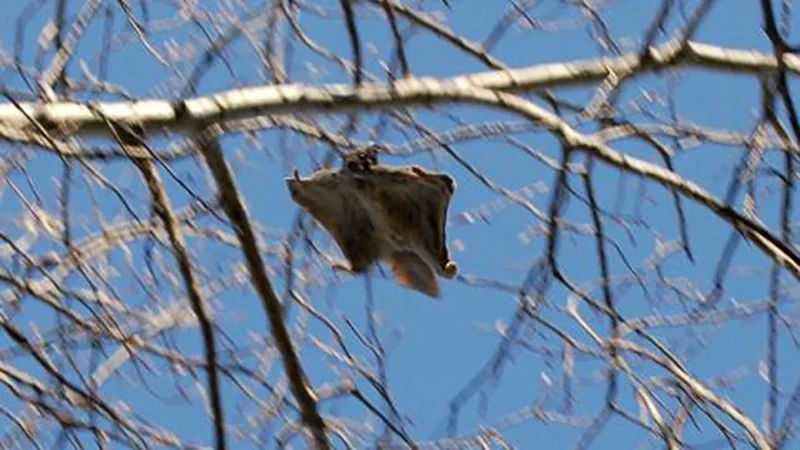Northern Flying Squirrel Facts
- This small mammal most frequently goes by the somewhat informative common name of the Northern Flying Squirrel across its range. It also represents one of only three living members of its genus, Glaucomys, to make its home in what’s now known as the New World.
- The intriguing creature does have another name by which it’s known, though. That’s because, like all species, it also holds a purely technical designation. Fortunately, this one’s relatively simple to pronounce, as such things go. It’s formally named the Glaucomys sabrinus.
- The animal received that unique moniker due to the efforts of the respected English zoologist and botanist, George Kearsley Shaw. He accomplished the first official recognition of it as a separate and distinct species. This scientifically noteworthy action occured in 1801.
- The surprising animal also remains noteworthy for another, astonishing fact. That’s due to the fact that researchers presently recognize a total of 24 subspecies of this small marvel of Nature! This fact alone distinguishes the marvel of Nature from the other members of its Order.
- For the moment, the Northern Flying Squirrel appears to be maintaining a population base that’s both sizable and stable. This fact also seems to hold true throughout the entirety of its known range. The IUCN, therefore, now lists it as Least Concern on its published Red List.
- The remarkable animal nevertheless does face some potential threats to its continued existence as a species. These, however, consist of the same one’s that most species presently face. These include habitat degradation and outright loss, and, of course, climate change.
Related Articles
Northern Flying Squirrel Physical Description
The remarkable Northern Flying Squirrel easily impresses those fortunate to encounter one. It does so, however, for reasons other than sheer size. Although it’s certainly a lovely animal, it’s not just its appearance that distinguishes it. That’s state exists due to other special characteristics.
Unlike many animals around the world, yet in keeping with the pattern established by other squirrels, this creature displays no noticeable degree of sexual dimorphism. Distinguishing the genders of specific individuals encountered therefore remains quite difficult for the casual observer.
In terms of physical size, though, it ranks as somewhat smaller than many of its multiple genetic cousins. Individuals attain an average overall length measuring 9.8 – 14.6 in (25 – 37 cm). That, however, includes the tail as well. This part of the body often comprises roughly half its length.
The body of the appealing rodent develops as quite slim and elongated. The majority of specimens reach an average body weight of only 2.6 – 4.9 oz (75 – 140 gms). Exceptional specimens occur, of course. Even these, though, rarely exceed these measurements by more than a small fraction.
It also displays several very specific adaptations useful for its lifestyle. These include having relatively large, black eyes. It also has the ability to rotate its hind feet, allowing it to climb down trees head first. Its fleshy membrane, however, easily remains its most noticeable physical feature.
In coloring, the fabulous Northern Flying Squirrel presents a pattern of various shades of light brown on the upper body. Yet, it also presents as gray on the flanks of its body. The underside, though, typically manifests a whitish shade. Its tail develops as fluffy, yet somewhat flattened.
- Kingdom: Animalia
- Phylum: Chordata
- Class: Mammalia
- Order: Rodentia
- Family: Sciuridae
- Genus: Glaucomys
- Species: G. sabrinus
Northern Flying Squirrel Distribution, Habitat, and Ecology
The fantastic Northern Flying Squirrel evolved as indigenous to a part of the globe already well known for its abundance of wildlife. That’s due to the fact that the amazing rodent lives on the continent of North America. There, though, its population remains somewhat disjointed in nature.
As its name implies, the great majority of its numbers appear in the northern part of the continent. More specifically, most of its population lives in the nation of Canada. It also appears as far north as the state of Alaska, though. The small wonder of Nature also appears in the United States.
In that country, it’s population’s scattered, though. To the west, it’s seen in California and Colorado. From there, it’s also observed to the northeast in Ohio, Wisconsin, and Michigan. In the east, the animal also lives in regions of Tennessee and North Carolina, in the Appalachian Mountains.
In each of these entirely separate regions, however, it displays identical habitat preferences. Populations most often appear in areas dominated by conifers. Some do, though, make their homes in regions of deciduous or mixed forests. It also prefers dense concentrations of trees, as well.
The wondrous Northern Flying Squirrel evolved as a mainly nocturnal animal. It’s also primarily arboreal in nature. On the ground, it’s relatively clumsy. Among the trees, though, it glides from limb to limb gracefully. Its main predators include hawks, owls, martens, and coyotes, among others.
Its diet remains typical of its kind. As a herbivore, it consumes a wide variety of locally available food. This fare typically includes such staples as various nuts, fungi, acorns, lichens, fruits, buds, and even tree sap. It does, however, occasionally supplement this with insects and even bird eggs.
Species Sharing Its Range
Check out our other articles on 7 Outstanding Orb Weavers, European Eel, Uluru, Baikal Seal, Petra Iris, Lau Banded Iguana, Delta Green Ground Beetle, Nicobar Pigeon, Japanese Hare

